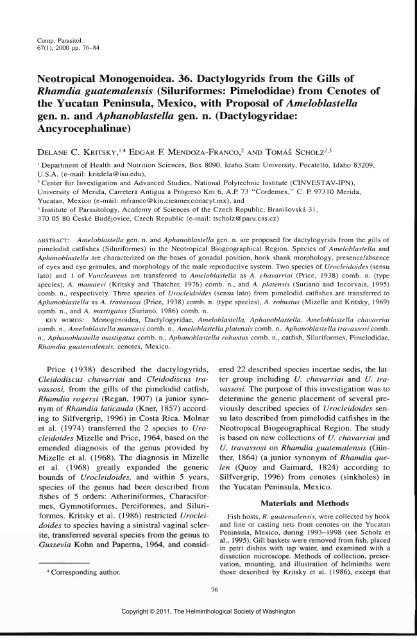Comparative Parasitology 67(1) 2000 - Peru State College
Comparative Parasitology 67(1) 2000 - Peru State College
Comparative Parasitology 67(1) 2000 - Peru State College
You also want an ePaper? Increase the reach of your titles
YUMPU automatically turns print PDFs into web optimized ePapers that Google loves.
Comp. Parasitol.<br />
<strong>67</strong>(1), <strong>2000</strong> pp. 76-84<br />
Neotropical Monogenoidea. 36. Dactylogyrids from the Gills of<br />
Rhamdia guatemalensis (Siluriformes: Pimelodidae) from Cenotes of<br />
the Yucatan Peninsula, Mexico, with Proposal of Ameloblastella<br />
gen. n. and Aphanoblastetta gen. n. (Dactylogyridae:<br />
Ancyrocephalinae)<br />
DELANE C. KRiTSKY,1-4 EDGAR F. MENDOZA-FRANCO,2 AND TOMAS ScHOLZ2'3<br />
1 Department of Health and Nutrition Sciences, Box 8090, Idaho <strong>State</strong> University, Pocatello, Idaho 83209,<br />
U.S.A. (e-mail: kritdela@isu.edu),<br />
2 Center for Investigation and Advanced Studies, National Polytechnic Institute (CINVESTAV-IPN),<br />
University of Merida, Carretera Antigua a Progreso Km 6, A.P. 73 "Cordemex," C. P. 97310 Merida,<br />
Yucatan, Mexico (e-mail: mfranco@kin.cieamer.conacyt.mx), and<br />
3 Institute of <strong>Parasitology</strong>, Academy of Sciences of the Czech Republic, Branisovska 31,<br />
370 05 80 Ceske Budejovice, Czech Republic (e-mail: tscholz@paru.cas.cz)<br />
ABSTRACT: Ameloblastella gen. n. and Aphanoblastella gen. n. are proposed for dactylogyrids from the gills of<br />
pimelodid catfishes (Siluriformes) in the Neotropical Biogeographical Region. Species of Ameloblastella and<br />
Aphanoblastella are characterized on the bases of gonadal position, hook shank morphology, presence/absence<br />
of eyes and eye granules, and morphology of the male reproductive system. Two species of Urocleidoides (sensu<br />
lato) and 1 of Vancleaveus are transferred to Ameloblastella as A. chavarriai (Price, 1938) comb. n. (type<br />
species), A. mamaevi (Kritsky and Thatcher, 1976) comb, n., and A. platensis (Suriano and Incorvaia, 1995)<br />
comb, n., respectively. Three species of Urocleidoides (sensu lato) from pimelodid catfishes are transferred to<br />
Aphanoblastella as A. travassosi (Price, 1938) comb. n. (type species), A. robiistus (Mizelle and Kritsky, 1969)<br />
comb, n., and A. mastigatus (Suriano, 1986) comb. n.<br />
KEY WORDS: Monogenoidea, Dactylogyridae, Ameloblastella, Aphanoblastella, Ameloblastella chavarriai<br />
comb, n., Ameloblastella mamaevi comb, n., Ameloblastella platensis comb, n., Aphanoblastella travassosi comb,<br />
n., Aphanoblastella mastigatus comb, n., Aphanoblastella robiistus comb, n., catfish, Siluriformes, Pimelodidae,<br />
Rhamdia guatemalensis, cenotes, Mexico.<br />
Price (1938) described the dactylogyrids,<br />
Cleidodiscus chavarriai and Clcidodiscus travassosi,<br />
from the gills of the pimelodid catfish,<br />
Rhamdia rogersi (Regan, 1907) (a junior synonym<br />
of Rhamdia laticauda (Kner, 1857) according<br />
to Silfvergrip, 1996) in Costa Rica. Molnar<br />
et al. (1974) transferred the 2 species to Urocleidoides<br />
Mizelle and Price, 1964, based on the<br />
emended diagnosis of the genus provided by<br />
Mizelle et al. (1968). The diagnosis in Mizelle<br />
et al. (1968) greatly expanded the generic<br />
bounds of Urocleidoides, and within 5 years,<br />
species of the genus had been described from<br />
fishes of 5 orders: Atheriniformes, Characiformes,<br />
Gymnotiformes, Perciformes, and Siluriformes.<br />
Kritsky et al. (1986) restricted Urocleidoides<br />
to species having a sinistral vaginal sclerite,<br />
transferred several species from the genus to<br />
Gussevia Kohn and Paperna, 1964, and consid-<br />
Corresponding author.<br />
Copyright © 2011, The Helminthological Society of Washington<br />
76<br />
ered 22 described species incertae sedis, the latter<br />
group including U. chavarriai and U. travassosi.<br />
The puipose of this investigation was to<br />
determine the generic placement of several previously<br />
described species of Urocleidoides sensu<br />
lato described from pimelodid catfishes in the<br />
Neotropical Biogeographical Region. The study<br />
is based on new collections of U. chavarriai and<br />
U. travassosi on Rhamdia guatemalensis (Giinther,<br />
1864) (a junior synonym of Rhamdia quelen<br />
(Quoy and Gaimard, 1824) according to<br />
Silfvergrip, 1996) from cenotes (sinkholes) in<br />
the Yucatan Peninsula, Mexico.<br />
Materials and Methods<br />
Fish hosts, R. guatemalensis, were collected by hook<br />
and line or casting nets from cenotes on the Yucatan<br />
Peninsula, Mexico, during 1993-1998 (see Scholz et<br />
al., 1995). Gill baskets were removed from fish, placed<br />
in petri dishes with tap water, and examined with a<br />
dissection microscope. Methods of collection, preservation,<br />
mounting, and illustration of helminths were<br />
those described by Kritsky et al. (1986), except that
















